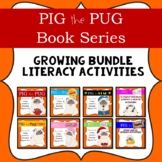Pig the Tourist by Aaron Blabey Literacy Activities .
- Zip
What educators are saying
Also included in
- Pig the Pug Book Series Print and Go Literacy Activities. Not only will your students LOVE these hilarious stories, they'll also have fun with these follow-up activities targeting language, comprehension and literacy. These books are brilliant rhyming read-aloud text, jam-packed with animals and silPrice $24.00Original Price $37.00Save $13.00
Description
Pig the Tourist by Aaron Blabey book study.
This packet includes ready to go book companion language art activities for a variety of levels from PK to early elementary so you can use one wonderful storybook across many classes.
When Pig, the world’s greediest Pug, goes on holiday, he causes CHAOS wherever he travels! However, in the end, Pig's rudeness comes back to bite him... Not only will your students LOVE this hilarious story, they'll also have fun with these follow-up activities targeting language, comprehension and literacy. I am not affiliated with the author, and the book is not included.
My products are designed in a clear, uncluttered format utilizing graphic organizers.
They are simple to read and are printer/ink friendly.
They are ready to print and go. This packet includes 34 pages of literacy activities.
Fonts included:
- USA: Simple Print in US Letter size (US spelling).
- Australia: Qld Beginners, NSW Print and Victorian print in A4 size (UK spelling).
- UK: Sassoon Primary Font A4(UK spelling).
These high engagement activities include:
- A beginning, middle and end retell page.
- Story map for characters, setting, problem and solution.
- A story maps for characters, setting, problem and solution.
- Character likes and dislikes.
- My Favorite Character covering:
What does my character look like?
How does my character act?
This is my favourite character because…
- KWL chart (2 options provided- learnt or learned).
- 2 sentence transformation.
- Write about your favourite character.
- Book review, text specific and generic.
- Character descriptions for Pig and Trevor using adjectives and verbs (with answers).
- Cut and paste character descriptions for Pig (with answers).
- Cut and match pictures to countries Pig visited (with answers).
- Text innovations using inference.
- 4 Writing prompts and story starters.
- Cut and paste matching rhyming words activities.
- Cut and paste and labelling activity in colour and B/W.
Beginning Middle End
Identifying the most important event from the beginning, middle and end of the story helps a reader understand how organization, sequence, and plot make a good story. This can then be applied to their own writing. Teaching students to retell occurrences in a story helps them become more accurate in summarizing and monitoring their understanding.
Story elements
A graphic organizer, such as a story map, can help students visually organize a story's elements, increasing their ability to retell, summarize, and comprehend the story.
Sentence transformations
This activity gives students practice with sentence structure (Syntax). Transforming words that are out of order forces students to think about each word in a sentence rather than only memorizing an entire phrase without understanding the importance of structure.
Writing prompts
Making connections is thinking about the text in relation to ourselves, other texts, and the world. Making connections provides the basis for learning, as students connect new information with their own experiences. This develops fluency with their comprehension skills.
Identifying rhyming words
Rhyming is a basic phonological awareness skill that develops a beginning understanding of the way sounds work within words. When students learn rhyming words, they are developing the ability to:
1. Break words down into smaller words.
2. Learn the rhythm of the written and spoken word.
3. Learn word families such as den, ben, ten, men, and pen.
4. Increases ability to spell new words.






